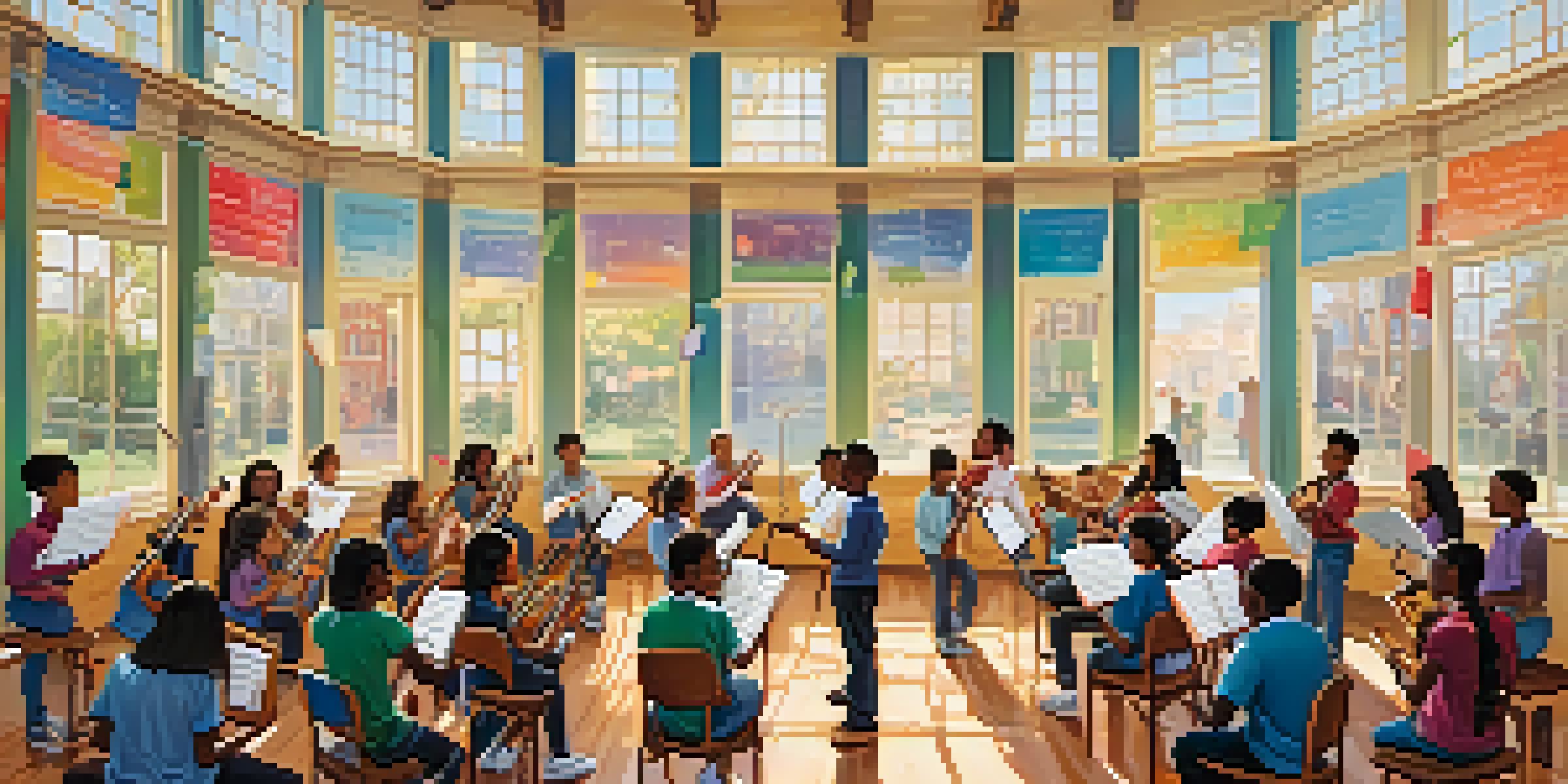The Influence of State Policies on School Music Education

Understanding State Policies and Their Role in Education
State policies are guidelines or laws set by government bodies that influence various sectors, including education. These policies can dictate everything from funding levels to curriculum standards. In the context of school music education, they shape how music programs are implemented and prioritized within the educational system.
Music can change the world because it can change people.
For example, a state that allocates specific funding for arts education may see a richer music program than one that does not. This shows how state priorities directly impact the resources available to schools. Understanding these policies helps educators navigate the landscape of music education more effectively.
Ultimately, state policies can either enhance or hinder the music education experience for students, making it crucial for educators and advocates to stay informed and engaged in policy discussions.
Funding: The Backbone of Music Education Programs
Funding is often the most visible way state policies influence school music education. When states allocate budget for arts programs, schools can afford instruments, qualified instructors, and performance opportunities. Conversely, a lack of funding can lead to music programs being cut or scaled back significantly.

Take, for instance, the impact of the Every Student Succeeds Act (ESSA), which emphasizes well-rounded education, including arts. States that embrace this act often see increased funding for music education. This financial support is essential for maintaining vibrant and engaging music programs.
State Policies Impact Music Education
State policies dictate funding and curriculum standards that directly influence the implementation and prioritization of music programs in schools.
Without adequate funding, music education can become an afterthought, causing students to miss out on the numerous benefits that music offers, from creativity to teamwork.
Curriculum Standards: Shaping Music Education Practices
Curriculum standards set forth by state policies establish what students should learn in music education. These standards can influence everything from the types of music taught to the skills emphasized in the classroom. For example, some states might prioritize classical music training, while others might focus on contemporary genres.
The beautiful thing about learning is that no one can take it away from you.
By providing a framework, these standards help educators design their lesson plans and assess student progress. They also ensure that all students have access to a comprehensive music education, regardless of where they live. This consistency is vital for maintaining educational equity.
However, rigid standards can also stifle creativity if they're too prescriptive, leaving little room for teachers to innovate or adapt their teaching methods to suit their students' interests.
Advocacy: The Role of Educators and Community
Advocacy plays a crucial role in shaping state policies on music education. Educators, parents, and community members can come together to voice their support for music programs, pushing for better funding and resources. This collective effort can bring significant changes at the state level.
For instance, grassroots movements have successfully lobbied for increased arts funding in various states. These efforts highlight the importance of community involvement in education and how local voices can influence policy decisions. When communities advocate for music education, they help raise awareness about its benefits.
Funding is Essential for Music Programs
Adequate funding is crucial for maintaining vibrant music education, providing necessary resources like instruments and qualified instructors.
Moreover, strong advocacy can lead to the establishment of music education coalitions, which further amplify the push for robust music programs in schools.
The Impact of Testing and Accountability on Music Education
Standardized testing and accountability measures can significantly impact how music education is perceived and prioritized by schools. When schools are evaluated primarily on test scores, subjects like music may receive less attention compared to core academic subjects. This shift in focus can lead to music programs being undervalued.
For example, schools might cut back on music classes to allocate more time for test preparation. This is a concerning trend, as it undermines the holistic development of students. Music education has been shown to enhance cognitive skills and creative thinking, qualities that are beneficial across all subjects.
As a result, it’s vital for advocates to demonstrate how music education contributes to a well-rounded curriculum and to push for policies that value all areas of learning equally.
The Influence of Cultural Factors on State Policies
Cultural factors also play a significant role in shaping state policies regarding music education. Regions with rich musical traditions may prioritize music programs more heavily, seeing them as essential to cultural preservation. This cultural appreciation can influence how policies are formulated and implemented.
For instance, states with strong ties to jazz, folk, or classical music may integrate these genres into their curriculum standards, fostering a deeper appreciation for local musical heritage. When policies reflect the cultural values of a community, they resonate more with students and educators alike.
Advocacy Drives Music Education Policy
Community and educator advocacy is vital in shaping state policies, ensuring that music education receives the support and recognition it deserves.
Conversely, areas that lack a vibrant musical culture may struggle to prioritize music education, often relegating it to the sidelines. Recognizing and valuing diverse musical traditions can lead to more inclusive and enriching music education programs.
The Future of School Music Education and State Policies
Looking ahead, the future of school music education will likely continue to be shaped by state policies, for better or worse. As communities push for more comprehensive arts education, it will be essential for policymakers to recognize the value of music in schools. This could lead to more supportive legislation and funding initiatives.
Moreover, as technology continues to evolve, there may be new opportunities for integrating music education into the digital landscape. Online resources and virtual classrooms can enhance music education access, particularly in underserved areas. State policies will need to adapt to these changes to ensure equitable access to music education for all students.

Ultimately, the collaboration between educators, policymakers, and communities will be crucial in fostering a future where music education thrives in schools, enriching the lives of students for years to come.